A Conservative party plan to limit the number of onshore windfarms would drive up household energy bills, according to the UK's most eminent engineers.
Replacing a single banned onshore turbine with offshore wind power, which is more expensive, would cost £300,000 a year more in subsidies, with the extra cost being added to bills, the Royal Academy of Engineering (RAE) said. The engineers also said a cap on turbines would make it harder to meet the UK's legally binding targets for renewable energy and cutting carbon emissions.
The intervention of the academy could undermine Tory plans to woo anti-windfarm campaigners at the general election and adds to criticism that David Cameron's energy policies are increasing bills. The new RAE report concludes that the UK energy system can easily accommodate a doubling of today's level of wind power, while acknowledging this would have an impact on local communities. It says the government should be "engaging honestly with stakeholders, setting out clearly both the impacts and the benefits".
Rear Admiral John Trewby, the RAE fellow who led the report, said: "Just to say we are going to cap onshore wind without consultation with the industry and other stakeholders would be a difficult decision to cope with. We need to have a strategic vision for the energy sector as a whole, not just talking about onshore wind in isolation."
Prof Richard Green at Imperial College London, who led the economic aspects of the report, said: "There would be some cost if you ended up not using onshore sites that would otherwise be suitable. For each large 3MW turbine that is capped out of existence on a fairly average onshore site, and is replaced by the appropriate fraction of a [larger] offshore turbine, that's about £300,000 per year per turbine. Those subsidies are recovered through electricity bills."
Green said: "Onshore wind is one of the cheapest ways of getting low carbon electricity [but] it will need a political consensus that we want to use our wind resources."
Another of the report's authors, Prof Gareth Harrison at University of Edinburgh, focused on the carbon emissions savings delivered by wind turbines. He said electricity from wind turbines resulted in emissions 40 times lower than gas and 80 times lower than coal, even when accounting for the entire life cycle of the turbine.
"Wind is a very good way of decarbonising [but] a cap will make that harder in many senses," he said. "You are pushed towards more expensive options and pushed towards more carbon-intensive sources. But my view appears to differ substantially from Cameron."
Wind power is intermittent but the RAE report concludes that its electricity generating capacity could more than double from today's 11GW by 2020 without any changes to how the energy system is balanced. That is because the grid already has robust systems in place to deal with the variable demand driven by, for example, cold snaps or popular television shows. Onshore wind accounts for 7GW or 5% of electricity generation, and offshore 4GW, or 3.3% of capacity.
The report also suggests wind power could double again by 2030, to about 58GW, but that this would require substantial changes to the way the grid is managed.
"It is not going to be hugely expensive, but it does require a new look at how we manage the energy assets on the system," said Prof Roger Kemp at Lancaster University and another report author. But he added: "If you go much beyond 50GW, you would have a lot of wind power not doing much a lot of the time" because the grid could not accommodate it.
On 4 April, a senior Conservative source told the Guardian the party was planning to include a moratorium on future onshore windfarms in its 2015 general election manifesto. "We want to control the number of onshore windfarms," he said. "We are mindful that uncontrolled expansion of onshore wind is alienating people from the whole clean energy debate. We think it is self-defeating."
The work by the RAE experts adds to criticism that Conservative decisions on energy are actually causing bills to rise. In March, official figures revealed that cuts to green schemes – after Cameron reportedly said he wanted rid of the "green crap" on energy bills – will mean more than 400,000 badly insulated households miss out on help to reduce their energy costs.
On Monday, former Liberal Democrat energy secretary Chris Huhne wrote in the Guardian: "The Conservatives have made a great play of trying to cut energy bills by axing the green levies that fund exactly the measures – energy-saving and cheap renewables – that will do most to protect households long term."
Around the world, the growth in installed wind power fell from 45GW to 35GW from 2012 to 2013, according to a report from the Global Wind Energy Council, also published on Thursday. However the GWEC expects that to rebound to 47GW in 2014, led by China, the US and record installations in Canada and Brazil.
"The global market is back on track for 2014. Wind is now a mainstream technology, and a central part of electricity market development in an increasing number of countries," said Steve Sawyer, GWEC secretary general. "But for the industry to reach its full potential, it is essential that governments get serious about climate change, and soon." The global total of installed wind power grew by 12% in 2013 to 318GW.
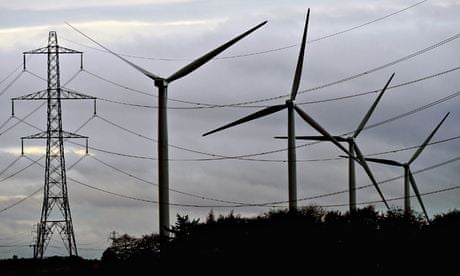


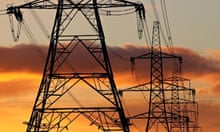
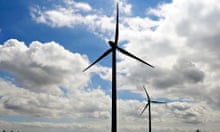


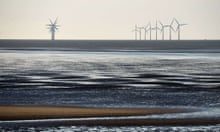

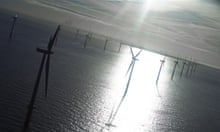
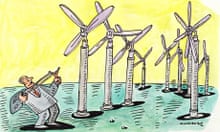
Comments (…)
Sign in or create your Guardian account to join the discussion